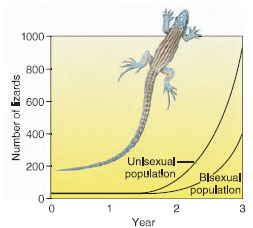Why Do So Many Animals Reproduce Sexually Rather Than Asexually?
Why Do So Many Animals
Reproduce Sexually Rather
Than Asexually?
Because sexual reproduction is so
nearly universal among animals, it
might be inferred to be highly advantageous.
Yet it is easier to list disadvantages
to sex than advantages. Sexual reproduction is complicated, requires
more time, and uses much more energy
than asexual reproduction. Mating
partners must come together and coordinate
their activities to produce
young. Many biologists believe that an
even more troublesome problem is the
“cost of meiosis.” A female that reproduces
asexually passes all of her genes
to her offspring. But when she reproduces
sexually the genome is divided
during meiosis and only half her genes
flow to the next generation. Another
cost is wastage in production of males,
many of which fail to reproduce and
thus consume resources that could be
applied to production of females.
Whiptail lizards of the American southwest
offer a fascinating example of the
potential advantage of parthenogenesis.
When unisexual and bisexual
species of the same genus are reared
under similar conditions in the laboratory,
the population of the unisexual
species grows more quickly because
all unisexual lizards (all females)
deposit eggs, whereas only 50% of the
bisexual lizards do so (Figure 7-4).
Variety may make sexual reproduction a winning strategy for the unstable environment, but some biologists believe that for many vertebrates sexual reproduction is unnecessary and may even be maladaptive. In animals in which most of the young survive to reproductive age (humans, for example), there is no demand for novel recombinations to cope with changing habitats. One offspring appears as successful as the next in each habitat. Significantly, parthenogenesis has evolved in several species of fish and in a few amphibians and reptiles. Such species are exclusively parthenogenetic, suggesting that where it has been possible to overcome the numerous constraints to making the transition, bisexual reproduction loses out.
Clearly, the costs of sexual reproduction are substantial. How are they offset? Biologists have disputed this question for years without producing an answer that satisfies everyone. Many biologists believe that sexual reproduction, with its breakup and recombination of genomes, keeps producing novel genotypes that in times of environmental change may survive and reproduce, whereas most others die. Variability, advocates of this viewpoint argue, is sexual reproduction’s trump card.
But is variability worth the biological costs of sexual reproduction? The underlying problem keeps coming back: asexual organisms, because they can have more offspring in a given time, appear to be more fit in Darwinian terms. And yet most metazoan animals are determinedly committed to sexuality. Considerable evidence suggests that asexual reproduction is most successful in colonizing new environments. When habitats are empty what matters most is rapid reproduction; variability matters little. But as habitats become more crowded, competition between species for resources increases. Selection becomes more intense, and genetic variability—new genotypes produced by recombination in sexual reproduction—furnishes the diversity that permits a population to resist extinction. Therefore, on a geological timescale, asexual lineages, because of the lack of genetic flexibility, may be more prone to extinction than sexual lineages. Sexual reproduction is therefore favored by species selection. There are many invertebrates that use both sexual and asexual reproduction, thus enjoying the advantages each has to offer.
 |
| Figure 7-4 Comparison of the growth of a population of unisexual whiptail lizards with a population of bisexual lizards. Because all individuals of the unisexual population are females, all produce eggs, whereas only half the bisexual population are egg-producing females. By the end of the third year the unisexual lizards are more than twice as numerous as the bisexual ones. |
Variety may make sexual reproduction a winning strategy for the unstable environment, but some biologists believe that for many vertebrates sexual reproduction is unnecessary and may even be maladaptive. In animals in which most of the young survive to reproductive age (humans, for example), there is no demand for novel recombinations to cope with changing habitats. One offspring appears as successful as the next in each habitat. Significantly, parthenogenesis has evolved in several species of fish and in a few amphibians and reptiles. Such species are exclusively parthenogenetic, suggesting that where it has been possible to overcome the numerous constraints to making the transition, bisexual reproduction loses out.
Clearly, the costs of sexual reproduction are substantial. How are they offset? Biologists have disputed this question for years without producing an answer that satisfies everyone. Many biologists believe that sexual reproduction, with its breakup and recombination of genomes, keeps producing novel genotypes that in times of environmental change may survive and reproduce, whereas most others die. Variability, advocates of this viewpoint argue, is sexual reproduction’s trump card.
But is variability worth the biological costs of sexual reproduction? The underlying problem keeps coming back: asexual organisms, because they can have more offspring in a given time, appear to be more fit in Darwinian terms. And yet most metazoan animals are determinedly committed to sexuality. Considerable evidence suggests that asexual reproduction is most successful in colonizing new environments. When habitats are empty what matters most is rapid reproduction; variability matters little. But as habitats become more crowded, competition between species for resources increases. Selection becomes more intense, and genetic variability—new genotypes produced by recombination in sexual reproduction—furnishes the diversity that permits a population to resist extinction. Therefore, on a geological timescale, asexual lineages, because of the lack of genetic flexibility, may be more prone to extinction than sexual lineages. Sexual reproduction is therefore favored by species selection. There are many invertebrates that use both sexual and asexual reproduction, thus enjoying the advantages each has to offer.




